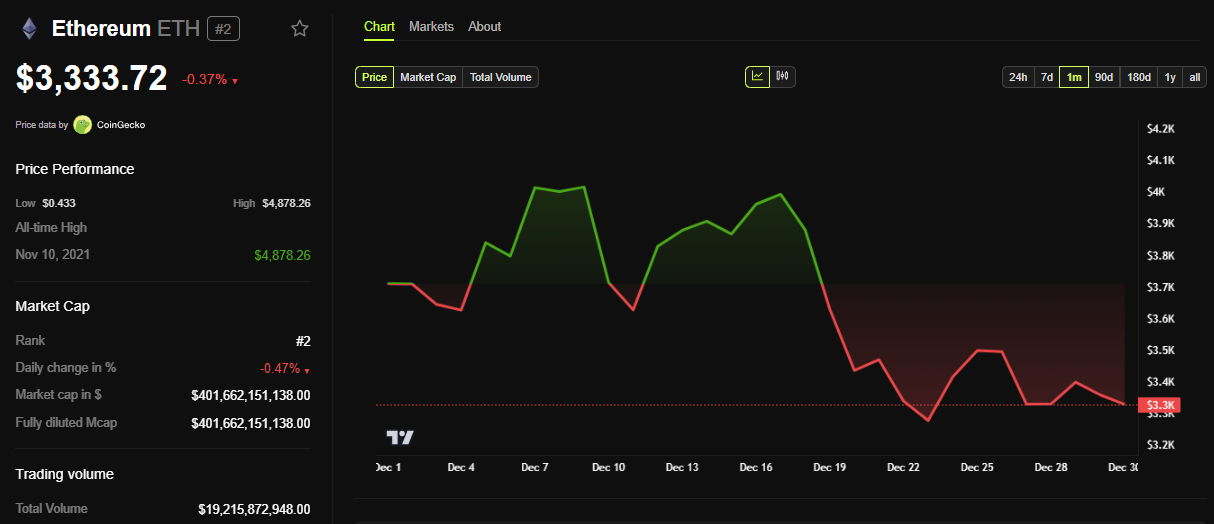December marked a historic milestone for Ethereum (ETH) exchange-traded funds (ETFs) in the United States, as net inflows reached $2.1 billion.
This made December the best performing month for Ethereum ETFs since their introduction in July 2024.
Ethereum ETFs Hit New Records in December
According to data from SoSoValue, BlackRock’s Ethereum ETF (ETHA) ranked first in December with $1,432 billion inflows. Fidelity’s Ethereum ETF (FETH) is behind with $752 million, while VanEck’s ETHV ranks third with $12 million. Bitwise achieved positive net inflows of up to $10 million, while Grayscale recorded negative outflows of $93 million.
On December 31, the Grayscale Ethereum Trust ETF (ETHE) continued to struggle, reporting a single-day outflow of $5.6 million and a total net outflow of $3.64 billion. Cryptocurrency researcher Trader T reflectrecorded monthly outflows of $274 million for Grayscale’s ETHE in December.

Despite the $2.1 billion milestone, Ethereum ETFs still lag behind Bitcoin. BlackRock’s Bitcoin ETF (IBIT) leads the market in 2024 with $37 billion in net capital, well ahead of Fidelity’s Bitcoin ETF (FBTC) at $12 billion. In contrast, BlackRock’s Ethereum ETF (ETHA) received $3.5 billion in capital in 2024, followed by Fidelity’s $1.5 billion.
While December’s record performance provided a much-needed boost, 2024 remains a challenging year for Ethereum. A report from 10X Research says Ethereum is having difficulty maintaining its position against emerging rival blockchains like Solana and Tron. Based on this and other reasons, 10X Research is skeptical about Ethereum’s prospects in 2025.
“The absence of significant catalysts and the risk of validator withdrawals are key challenges. Unless Ethereum can innovate and regain user interest, the lag behind Bitcoin is likely to continue,” the report said. stated clearly.
Ethereum’s difficult 2024 is clearly reflected in its performance: while Bitcoin is up 120%, Ethereum is only up 48%. The 70% underperformance against Bitcoin has raised questions about the value of Ethereum and the effectiveness of ongoing upgrades.
These Concerns About Staking and Stagnation of Ethereum Usage
According to 10X, one of Ethereum’s strengths, staking, has also come under criticism. With 28% of all ETH being staked, many argue that Ethereum has become a passive means of income instead of a blockchain actively used for DeFi and other activities. Staking yields, currently around 3%, become less attractive than traditional finance (TradFi) rates.
The Ethereum network has also struggled to recover its peak activity. Weekly transactions, which peaked at 11 million in May 2021, have now dropped to around 9 million. Similarly, weekly active addresses fluctuate between 300K and 400K.
“Ethereum’s stagnation contrasts sharply with the growth of alternative blockchains. The decline in user activity and failure to drive innovation points to a deeper systemic problem,” 10X Research added.
Other concerns lie in trends among validators. The 1-month growth rate of active validators has turned negative, raising concerns that some may leave the network. If this trend accelerates, it could put further downward pressure on ETH.
Furthermore, Ethereum’s strike price – the average price at which the entire ETH supply was last moved on-chain – is currently at $2,093. This is below the average sending price for staked ETH of $2,383, suggesting that validators could face losses if the price continues to fall.
While challenges persist, December’s capital inflows underscore Ethereum’s enduring appeal to institutional investors. As the ETH ETF market matures, Ethereum could benefit from wider adoption and improved liquidity.

Data from TinTucBitcoin shows that ETH is down 0.37% since Wednesday’s trading session opened. As of the time of writing, the price of Ethereum is 3,333 USD.
